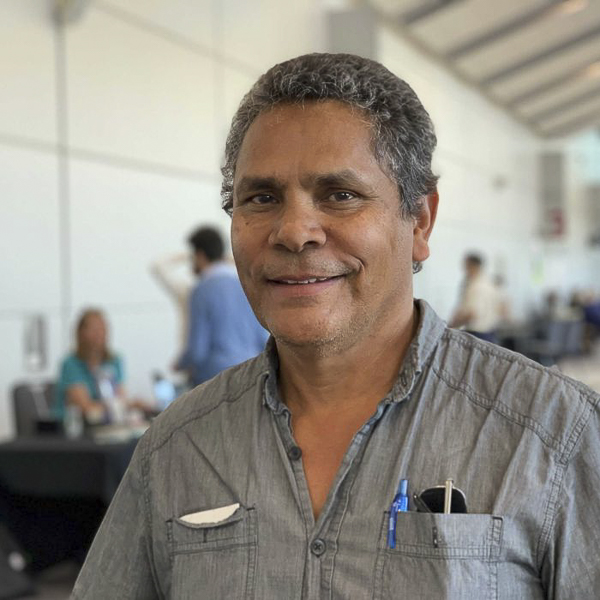 Mr Gerry Turpin
Mr Gerry Turpin
Senior ethnobotanist and coordinator, Tropical Indigenous Ethnobotany Centre, Australian Tropical Herbarium, Queensland Department of Environment, Science and Innovation.
See Mr Turpin’s full research profile here.
Research outputs linked to policy change and decision-making
Indigenous knowledge is recognised globally for its valuable contribution to western sciences in managing major challenges like climate change, food security and biodiversity. The Tropical Indigenous Ethnobotany Centre (TIEC) acts as a bridge between Indigenous biocultural knowledge and western science, partnering research organisations with Traditional Owner groups in collaborative research. It aims to develop and enhance community capability and strengthen community awareness of cultural biodiversity for a sustainable future. Specific projects include:
- Building the Traditional Owner-led bush products sector. Gerry attended several workshops to provide cultural knowledge and guidance to participants. The workshops brought together Indigenous and non-Indigenous leaders and organisations from the Indigenous-led bush products sector to develop priorities, overcome challenges and provide support to the sector (2019).
- Muunthiwarra Traditional Owners return to Country project. Gerry joined a field trip to Jack Lakes with the Muunthiwarra clan of the Guugu Yimithirr language group, some members going on country for the first time. Jack Lakes is a significant hunting, fishing, and ceremonial place for the Muunthiwarra clan group. The aim was to record and document traditional plant use, including bush tucker and bush medicine. A vegetation communities and regional ecosystem survey, including weeds survey was also conducted (2018).
- Mangrove dieback in the Gulf of Carpentaria: baseline for monitoring future trajectories in Queensland with Normanton Rangers, Queensland Herbarium and Pompuraaw Council. A program to monitor the recovery of mangroves and associated communities within the Queensland portion of the Gulf of Carpentaria (from the western tip of Cape York Peninsula to the Northern Territory border). This program covers the establishment of a network of permanent monitoring transects and a program of change-detection mapping of the mangrove dieback. The information gathered in each transect includes full floristic and structural information following the vegetation mapping methodology using CORVEG sites. Additional structural measurements of tree height and diameter at breast height as well as relative ground-surface elevations were documented. The aim is to revisit these sites every three years (2017 and 2018).
- Acacia purpureopetala (purple wattle) survey on Mbabaram Country. Two field surveys were carried out to evaluate the critically endangered Acacia purpureopetala populations to better understand the management requirements of this unique wattle. The project documented the current extent of Acacia purpureopetala populations and also found undocumented, additional populations (2018).
- Two-way knowledge system between Indigenous knowledge and the Atlas of Living Australia (ALA). The project developed a 2-way knowledge system linking Indigenous knowledge and the knowledge and data in the ALA database. The project identified ways to manage risks for Indigenous peoples using ALA, supported the Olkola Aboriginal Corporation’s aspirations for management of Country, culture and economic development, and worked with its partners to create a system to collect, store and transfer Olkola land management and cultural data. With support, Olkola promoted a case study document and a short film of the project with research archival material and reference sources (2015).
- Scenario planning and land use occupation mapping with Indigenous people in reef catchments. The project investigated opportunities and ways to work with Indigenous groups to include Indigenous perspective and aspirations into natural resource management (NRM) planning for climate change. Report given to Reef Catchments NRM body for inclusion in their Reef Catchments NRM management strategy (2014).
- Using biomedical science to maintain use of customary medicines: a case study with two Australian Indigenous communities. Mr Turpin led the first part of the project as Indigenous leader of TIEC. The National Institute of Complementary Medicine was engaged to conduct antimicrobial analysis on a selection of de-identified medicinal plant parts of cultural significance to the Mbabaram community. Report on the Atlas of Living Australia pilot project with Olkola people (2016).
Highest qualification
- Master of Philosophy (Medical and Biomolecular Sciences), James Cook University.
Major prizes, medals and honours
- 2014: Banksia Foundation Sustainability Award for Indigenous Leadership for Sustainability (member of Indigenous biocultural knowledge working group)
- 2013: Deadly Award for Scientist or Science Project of the Year at the National Aboriginal & Torres Strait Islander Music, Sport, and Entertainment & Community Awards
- 2011: Length of Service Certificate in recognition of 22 years of service from the Queensland Government
- 2009: Highly Commended Technical and Professional Excellence from the acting Director-General, Queensland Government, for Herbarium survey, mapping and monitoring of regional ecosystem projects.
Links with non-government groups or networks
- 2019: baseline assessment of the natural, pyrological and cultural resources of the Juuju Daarrba Nhirrpan National Park (Cape York Peninsula Aboriginal Land; CYPAL) with Buubu Gijin Aboriginal Corporation
- 2019: National Indigenous Fire Workshop with the National Indigenous Fire Network, Firesticks and Cape York NRM – provided workshops for vegetation site data collection, plant identification and promote TIEC
- 2019: Northern Gulf Indigenous Fire Forum with Ewamian Aboriginal Corporation and Northern Gulf NRM – plant collection and identification, provide ethnobotany expertise for recording and documenting for incorporating into a database
- 2017: ethnobotanical pre-burn cultural assessment with Batavia Traditional Owners Aboriginal Corporations and Queensland Parks and Wildlife, Coen. Revisiting and undertaking ethnobotanical surveys and biocondition assessments of vegetation monitoring sites established by the Queensland Herbarium in the 1990s during the CYPLUS study; Identify sites of significance and culturally appropriate fire management techniques for particular ecosystems and cultural protocols for QPWS fire management; identify permanent vegetation monitoring plots for monitoring changing fire regimes
- 2016: National Indigenous Fire Workshop with Jabalbinna Rangers, Wujal Wujal Council, Cape York NRM and National Indigenous Fire Network.
My Projects
 Current project
Current project Completed project
Completed project
NESP RLH, 2021-2027NESP, 2015-2021NERP, 2012-2015TRaCK, 2005-present
 Mr Gerry Turpin
Mr Gerry Turpin